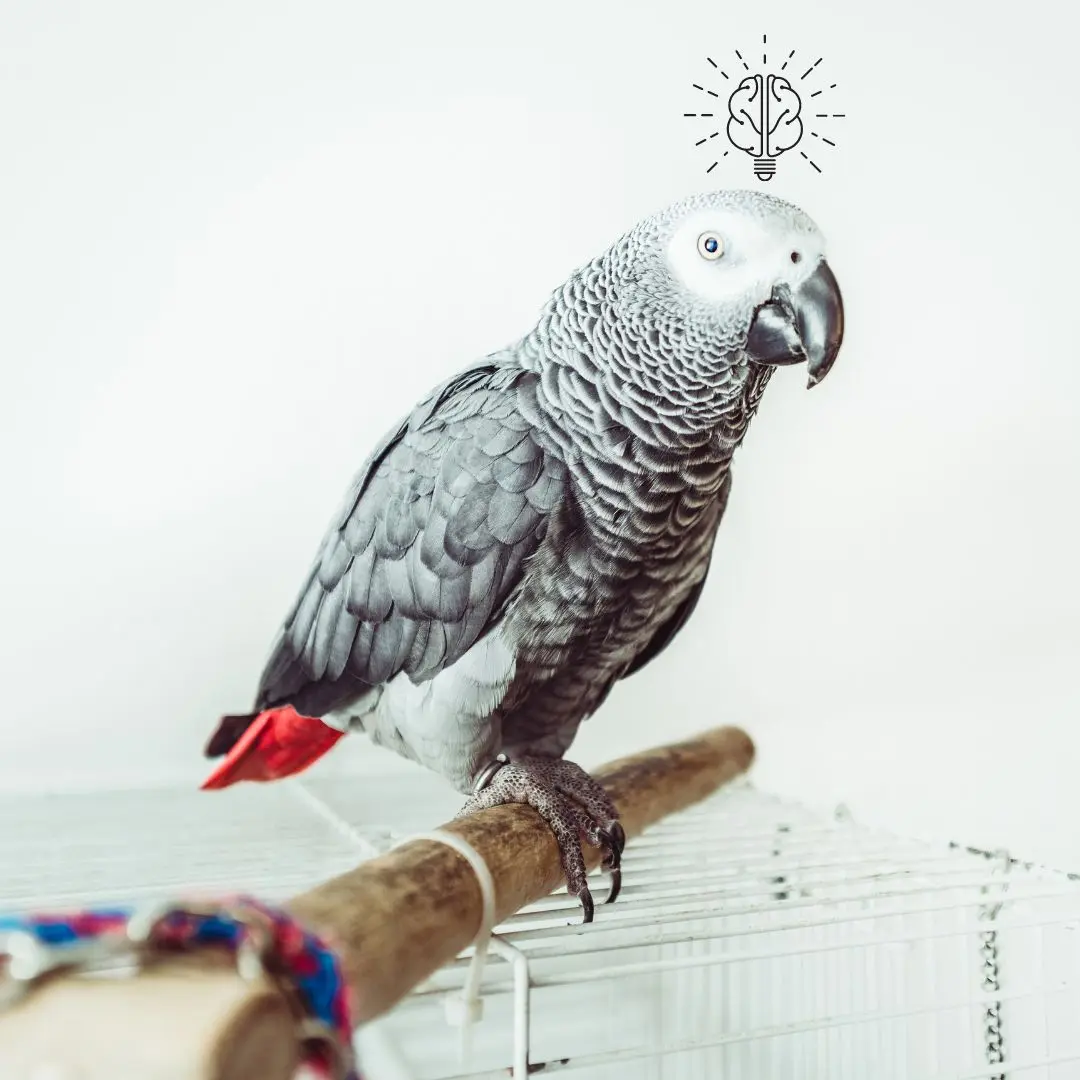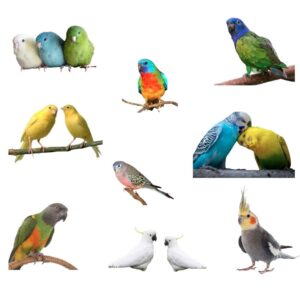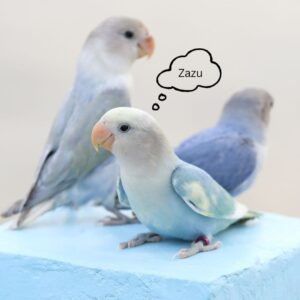African Gray parrots can mimic human speech, talk in our language, demonstrate object permanence, use tools, and even grasp abstract concepts, making them one of the most cognitively sophisticated non-human species.
Ornithologists have considered Alex to be the most intelligent African Gray. He had over 100 vocal labels for different objects, actions, and colors, even identifying objects by their specific material.
Demonstrating advanced math skills in animal intelligence, he understood the connection between written numerals, object sets, and vocalized numbers. So, he could count object sets up to six and was progressing to seven and eight.
In his everyday life, Alex often instructed his human companions on when it was time for dinner to go back to the cage to sleep. He was so smart he even assisted his fellow birds Wart and Griffin, he alternately encouraged or scolded them during lessons – much like a school teacher.
Fun fact: His cherished toys that helped him drastically improve his cognitive skills included foraging cardboard boxes, key chains, and corks.
Let’s talk about African Gray parrot intelligence, how they show it, and how to encourage your bird to show it.
African Gray Parrot Intelligence
How Intelligent Is an African Gray Parrot?
While African Grays rank among the most intelligent animals on the planet, there’s no specific IQ statistic that shows exactly how much intelligence they have on average.
However, an African Gray parrot intelligence test conducted at Harvard University suggests that an African Gray parrot can be as intelligent as a four to five-year-old child.
And with adequate mental stimulation, the intelligence of African Grays can be equal to six to eight-year-olds. Now, you might be wondering how is this possible.
The well-known psychologist, who’s also a parrot enthusiast, Irene Pepperberg, suggests that intelligent parrots like African Gray share a common ancestor from the dinosaur era with us.
So, it’s possible that African Grays have developed strong cognitive levels over time. Although their brain is tiny, it’s so densely packed neurons, that it’s comparable with non-human primates.
The intelligence of these remarkable birds manifests in their ability to:
- Grasp cause-and-effect situations
- Use tools to achieve objectives
- Comprehend basic arithmetic, counting up to eight items – though in most cases, it’s less than that
- Distinguish colors and shapes
- Understand the meaning of simple words and phrases
For better insights into African Gray parrot intelligence, check out this brief YouTube summary of Griffin’s (African Gray parrot) cognitive test results conducted at Harvard University:
Common Ways African Grays Showcase Their Intelligence
Here are some of the most common ways of intellectual behavior that can help you understand how intelligent can an African Gray parrot be:
Mimicry
African Gray parrots aren’t mere imitators; they’re masters of mimicry, capable of accurately replicating human speech. They have remarkable mimicry due to well-developed auditory perception, syrinx (a complex vocal muscle responsible for sound mimicry and talking ability), and high intellect.
African Grays have an uncanny ability to mimic words, intonations, accents, and even tone levels.
Talking
African Gray parrots have a complex understanding of language and can associate words with objects, actions, numbers, colors, and emotions. They can even learn new words and phrases and use language to solve problems and get what they want.
This ability allows them to engage in rudimentary conversations, respond to questions, and even initiate simple conversations themselves.
With enough interaction and bonding, an African gray can learn to say hundreds of words and phrases and keep the simple conversation going.
Problem-Solving Skills
African gray parrots are not limited to concrete concepts; they can grasp abstract ideas such as “same” and “different,” “bigger” and “smaller,” and various colors and shapes. This ability suggests a level of cognitive sophistication that goes beyond mere mimicry.
They can categorize objects based on shared traits, recognize patterns, and even make inferences. The ability to engage in conceptual learning allows them to understand the world in a more abstract and ‘’expressed’’ way, allowing them to make predictions and solve problems more effectively.
Their cognitive prowess enables them to devise solutions to challenges that most birds can’t often comprehend. For example, using sticks to retrieve food from hard-to-reach locations.
Cooperative Behaviors
African grey parrots exhibit a remarkable capacity for cooperation, engaging in behaviors that benefit both themselves and their companions. These cooperative behaviors include:
- Food Sharing: They share food, demonstrating a sense of kinship and mutual care.
- Allopreening: They assist each other in grooming, maintaining their feathers, and strengthening social bonds.
- Collective Defense: They work together to defend themselves from predators, sharing information and coordinating their actions.
Here’s an example of an African Gray helping their fellow companion, as an experiment at Max Plank Institute for Ornithology:
Object Permanence
Object permanence is the understanding that objects continue to exist even when out of sight. This ability is important for African Gray parrots because it allows them to find food, avoid predators, and navigate their environment.
For example, one study found that African Gray parrots could find hidden objects even when the objects weren’t in sight. This suggests that they could remember what that object was and where it was hidden, even though they could no longer see it.
Spatial Reasoning
Spatial reasoning is the ability to understand the reason for the spatial relationships between objects. This ability is important for African Gray parrots because it allows them to manipulate objects, solve puzzles, and navigate their environment much more easily.
Based on the research from the (previously mentioned) Max Plank Institute, African Grays can learn to use a tool to retrieve food from a tube. This suggests that they were able to understand the spatial relationships between the tool, the food, and the tube.
Tool Use and Innovation
African Gray parrots are also skilled tool users and innovators. They can use tools to achieve various goals, such as retrieving food, manipulating objects, solving puzzles, and more! They can also adapt their behavior to use new tools and invent their own.
For instance, African Grays in their natural habitats often use sticks to pry open termite mounds and access the insects inside.
In captivity, they use sticks, wires, or other similar tools to retrieve food from places too narrow for their beaks.
However, African Gray doesn’t only use the tools from their environment. They can also innovate and come up with new ways to use them.
For example, here’s a short video of a cute African Gray using a random stick as a back-scratching tool:
Now, what makes an African Gray capable of this behavior?
Here are a few factors:
- Intelligence: African Grays are among the most intelligent bird species. This means they have developed the cognitive ability to understand and use the tools around them.
- Playfulness: They’re incredibly playful birds, leading them to experiment with different objects and discover new ways to use them.
- Social learning: African Gray parrots can learn how to use tools from other parrots. This social learning can help them to learn new behaviors quickly and efficiently, which benefits not only their cognitive ability but also their social needs.
Abstract Thoughts
Abstract thought involves the ability to reason about concepts that aren’t directly tied to physical objects or sensory experiences. African Grays have exhibited signs of abstract thought in the following ways:
- Pattern Recognition: They can identify patterns and sequences, suggesting an ability to think beyond individual objects.
- Inferential Reasoning: An African Gray can make inferences (conclusions reached based on evidence and reasoning) with limited information, demonstrating an ability to comprehend an event.
- Hypothetical Reasoning: They can even engage in hypothetical reasoning, considering possibilities that aren’t immediately present in the environment and may not be obvious at first.
One of the best examples of abstract thoughts in African Grays is the multiple-cup task test that psychologist Irene Pepperberg conducted with apes, children around five, and her African Gray parrot Griffin.
One test included three cups. One reward/object was hidden in a single cup, and another was in one of two additional cups; to one side of the first cup. When faced with a choice, participants had to pick a single cup.
Most children and apes would fail at a task of the same or similar complexity. But it was different with Griffin – he outperformed even the five-year-olds.
Then, the researchers even conducted a four-cup test, resulting in the same outcome – Griffin beat the competition again.
For a brief demonstration, here’s a quick video recorded during the test:
Self-Awareness and Emotional Intelligence
Many African Grays exhibit self-awareness, recognizing their reflection in a mirror and engaging in self-grooming or talking to themselves. This suggests a rare level of consciousness and self-recognition among other animals.
Also, they often display emotions such as happiness, sadness, frustration, and sometimes jealousy. Due to this awareness and level of emotional intelligence, it’s not surprising that some African Gray parrots can respond to our emotions.
Lifelong Learning and Adaptability of African Gray Parrots
The African Gray parrot’s intelligence is similar to ours regarding learning and adaptability. Their life expectancy depending on living conditions, is 22-60 years. Like us, an African Gray parrot can learn throughout its life – and exhibit an innate curiosity and a persistent drive to keep learning.
Here are a few common ways your African Gray may show its curiosity over time:
- Vocabulary Expansion: Once African Gray parrots start mimicking sounds and get comfortable talking, they’ll get more accustomed to frequent repetition of these mimics. Also, they’ll start learning new words, phrases, and other sounds more quickly – they’ll even grasp different tones and accents.
- Tool Use Innovation: Although not every African Gray will easily use tools lying around, some start from an early age. They’ll adapt their tool-using techniques to new situations, demonstrating creativity and problem-solving abilities.
- Social Interaction: Over time, there’s a high chance your African Gray parrot will continuously learn and adapt their social interactions. This can lead to a better understanding of new social cues and a more natural, more appropriate response.
- Environmental Adaptability: African Grays can adapt to new habitats, food sources, and social structures in general, demonstrating their learning potential and adaptable mindset.
A small tip: Remember that most African Grays, although capable of adaptation, don’t like sudden and drastic environmental changes. So be careful how often and how much you change their feeding places, position of perches and toys, cage, etc.
Grays also require large cages, so make sure their habitat offers optimal conditions for their well-being.
Social Behavior and Bonding
African grey parrots are highly social creatures, forming strong bonds with their owners and fellow parrots. They engage in cooperative behaviors, such as sharing food and assisting each other in tasks. These social interactions contribute to their cognitive development and emotional well-being.
Encouraging Mental Stimulation in Your African Gray
Not to discourage you, but due to their intelligence and playful nature, it can be difficult for African Grays to stay occupied. That’s why it takes more time and effort to provide enough mental and emotional interaction to an African Gray – but don’t worry.
Here are some of the most efficient and fun ways to help encourage mental stimulation and provide your African Gray(s) with plenty of interaction:
Teaching Shapes and Colors
Introducing shapes and colors to your African Grey can be an engaging and intellectually stimulating experience. Use colorful toys and treats, associating specific shapes and colors with each item. Also, don’t forget about repetition, allowing your parrot to learn gradually, at a comfortable pace.
For instance, you could present a red ball. Tell your parrot that is a ball and say that its color is red – keep repeating the word as your parrot interacts with it. Then, repeat the same process for a different object of a different color this time.
Over time, they’ll gain the ability to recognize and differentiate between various shapes and colors.
Teaching Simple Words and Phrases
Since African Grays can be talkative parrots, engage them in short, clear repetitions of words you want them to pick up. But be sure to create a positive and encouraging environment, celebrating their successful mimicry and talking with treats and praise.
Start with basic words like “hello” or “good bird” and gradually progress to short phrases. Some of the best ones would be ‘’want a snack’’ or ‘’want water’’, as these will help them associate a specific phrase they need to say when hungry or thirsty.
The process exercises their memory and linguistic abilities and strengthens the communication bond between you and your parrot.
Pro tip: You can use an interactive toy with a voice recorder and record your voice, so your African Gray can interact with it and play the sound on repeat.
Training Flight and Landing
Teaching your African Grey to land back on your hand or their cage after flying around enhances their physical fitness and stimulates their problem-solving skills.
Gently encourage your parrot to take short flights, extending the distance gradually. Use treats to reward proper landings – this way, you’ll have a high chance of teaching your African Gray where it’s safe to land.
However, engage in this training in a secure, controlled environment. There shouldn’t be any ventilation fans, dangling cables, sharp objects, or even poisonous plants.
This training can assist in honing their flying abilities, foster trust and confidence in their relationship with you, and help provide enough mental stimulation through problem-solving as your parrot learns to navigate the aerial space and land precisely as instructed.
Remember: Keep in mind that you should visit and consult your vet and expert in training birds before you engage in these types of training.
Puzzle Toys for Cognitive Challenges
Providing interactive puzzle toys for your African Gray can significantly improve cognitive abilities. Some bird toys often reward the parrot by dispensing treats when used correctly, encouraging problem-solving behavior.
Try to opt for toys that require your birdie to perform various actions to access the treats, such as sliding lids or turning knobs. The interactive nature of puzzle toys mimics the mental challenges an African Gray might encounter in the wild, providing a stimulating experience within the comfort of their home environment.
Here are some examples of our favorite toys. You can find them on Amazon:
But keep in mind that African Grays can easily become bored if they keep playing with only a few simple toys for a long period – so be sure to provide your birdies with various toys and don’t forget to move or swap them occasionally.
Foraging Activities for Natural Instincts
Like any other parrots, African Grays are natural foragers in the wild, and encouraging foraging activities in their daily activities helps nurture these instincts. So try hiding treats in different places within their cage, encouraging exploration and problem-solving challenges to retrieve the rewards.
This provides mental stimulation and ensures physical activity as they move around their environment.
Vet Q&A
Do African Grey parrots understand humans?
Yes, African Grays understand humans. They can understand the names of objects, colors, shapes, the meaning of the simple words we commonly use, and even our state of mind – emotions like being happy, sad, angry, etc.
Are African Greys more intelligent than dogs?
Generally speaking, yes. African Grays are more intelligent than dogs. This is not solely based on the distinct behavior of these amazing pets, but because parrots can mimic, comprehend, and say words we use, unlike dogs.
Do African Greys talk a lot?
Yes, African Grays do talk a lot. When it comes to birds that talk, African Grays are undoubtedly one of the most talkative birds. Not only they can mimic and learn to say simple words and phrases, but they can also understand a lot of our common words and phrases.
My Senior Paws is a participant in the Amazon Services LLC Associates Program, an affiliate advertising program designed to provide a means for sites to earn advertising fees by advertising and linking to Amazon.com. We also participate in other affiliate programs which compensate us for referring traffic.




